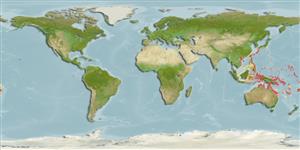>
Gobiiformes (Gobies) >
Gobiidae (Gobies) > Gobionellinae
Etymology: Redigobius: Latin,. Redere = to come back + Latin, gobius = gudgeon.
More on author: Herre.
Environment: milieu / climate zone / depth range / distribution range
Écologie
marin; eau douce; saumâtre benthopélagique; dH range: ? - 8; amphidrome (Ref. 59012); profondeur 0 - 5 m (Ref. 86942). Tropical; 25°C - 28°C (Ref. 2060)
Asia: Sri Lanka, Philippines, Malaysia and Indonesia (Ref. 13235); Japan (Ref.43239). Oceania: New Guinea. Reported from New Caledonia (Ref. 13235), Micronesia (Ref. 59012). Africa: Mozambique. Indian Ocean: Madagascar, Mayotte (Ref. 55749).
Taille / Poids / Âge
Maturity: Lm ? range ? - ? cm
Max length : 3.8 cm SL mâle / non sexé; (Ref. 44894)
Description synthétique
Clés d'identification | Morphologie | Morphométrie
Épines dorsales (Total) : 7; Rayons mous dorsaux (Total) : 6 - 7; Épines anales: 1; Rayons mous anaux: 6. Distinguished by the following characteristics: moderate-sized Redigobius; single black band extending down and back from tip of first dorsal fin; distinct black band extending from eye diagonally across opercle to lower edge of pectoral fin base; first dorsal fin tall and elongate, third or fourth spine longest; opercle with small ctenoid scales; 14 circumpeduncular scales; second dorsal rays modally I,7; anal rays I,6; pectoral rays 16-17; longitudinal scales 23-25; TRB 9-11; predorsal scales 9-12 (Ref. 84480).
Adults inhabit coastal estuaries, lakes (Ref. 48637), and entering lower reaches of freshwater streams (Ref. 44894). Also found in quiet mangrove estuarine habitats (Ref. 84480). Also Ref. 43716.
Life cycle and mating behavior
Maturities | Reproduction | Spawnings | Egg(s) | Fecundities | Larves
Keith, P., G. Marquet, P. Valade, P. Bosc and E. Vigneux, 2006. Atlas des poissons et des crustacés d'eau douce des Comores, Mascareignes et Seychelles. Muséum national d’Histoire naturelle, Paris. Patrimoines naturels, 65:250p. (Ref. 57749)
Statut dans la liste rouge de l'IUCN (Ref. 130435)
Menace pour l'homme
Harmless
Utilisations par l'homme
Outils
Articles particuliers
Télécharger en XML
Sources Internet
Estimates based on models
Preferred temperature (Ref.
123201): 25.4 - 29.3, mean 28.6 °C (based on 1307 cells).
Phylogenetic diversity index (Ref.
82804): PD
50 = 0.5000 [Uniqueness, from 0.5 = low to 2.0 = high].
Bayesian length-weight: a=0.00977 (0.00442 - 0.02163), b=3.05 (2.86 - 3.24), in cm total length, based on LWR estimates for this (Sub)family-body shape (Ref.
93245).
Niveau trophique (Ref.
69278): 3.3 ±0.4 se; based on size and trophs of closest relatives
Résilience (Ref.
120179): Haut, temps minimum de doublement de population inférieur à 15 mois (Preliminary K or Fecundity.).
Fishing Vulnerability (Ref.
59153): Low vulnerability (10 of 100).
